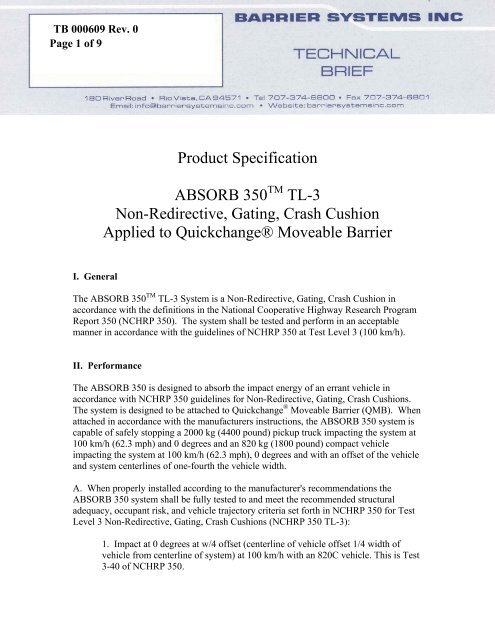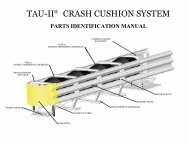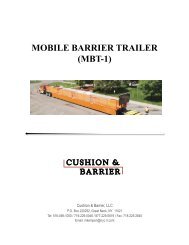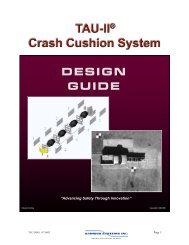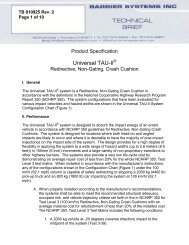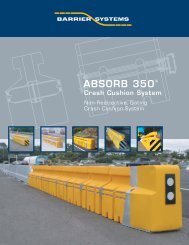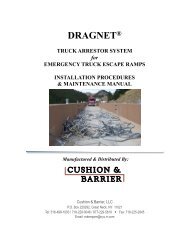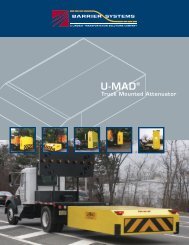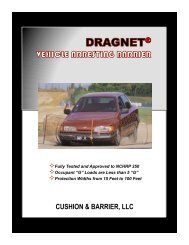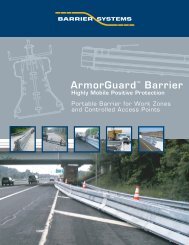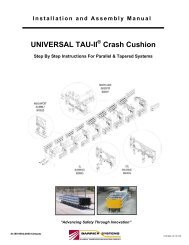Absorb 350 QMB FHWA Letter(TL-3) - Impact Absorption Inc
Absorb 350 QMB FHWA Letter(TL-3) - Impact Absorption Inc
Absorb 350 QMB FHWA Letter(TL-3) - Impact Absorption Inc
Create successful ePaper yourself
Turn your PDF publications into a flip-book with our unique Google optimized e-Paper software.
TB 000609 Rev. 0<br />
Page 1 of 9<br />
Product Specification<br />
ABSORB <strong>350</strong> TM <strong>TL</strong>-3<br />
Non-Redirective, Gating, Crash Cushion<br />
Applied to Quickchange® Moveable Barrier<br />
I. General<br />
The ABSORB <strong>350</strong> TM <strong>TL</strong>-3 System is a Non-Redirective, Gating, Crash Cushion in<br />
accordance with the definitions in the National Cooperative Highway Research Program<br />
Report <strong>350</strong> (NCHRP <strong>350</strong>). The system shall be tested and perform in an acceptable<br />
manner in accordance with the guidelines of NCHRP <strong>350</strong> at Test Level 3 (100 km/h).<br />
II. Performance<br />
The ABSORB <strong>350</strong> is designed to absorb the impact energy of an errant vehicle in<br />
accordance with NCHRP <strong>350</strong> guidelines for Non-Redirective, Gating, Crash Cushions.<br />
The system is designed to be attached to Quickchange ® Moveable Barrier (<strong>QMB</strong>). When<br />
attached in accordance with the manufacturers instructions, the ABSORB <strong>350</strong> system is<br />
capable of safely stopping a 2000 kg (4400 pound) pickup truck impacting the system at<br />
100 km/h (62.3 mph) and 0 degrees and an 820 kg (1800 pound) compact vehicle<br />
impacting the system at 100 km/h (62.3 mph), 0 degrees and with an offset of the vehicle<br />
and system centerlines of one-fourth the vehicle width.<br />
A. When properly installed according to the manufacturer's recommendations the<br />
ABSORB <strong>350</strong> system shall be fully tested to and meet the recommended structural<br />
adequacy, occupant risk, and vehicle trajectory criteria set forth in NCHRP <strong>350</strong> for Test<br />
Level 3 Non-Redirective, Gating, Crash Cushions (NCHRP <strong>350</strong> <strong>TL</strong>-3):<br />
1. <strong>Impact</strong> at 0 degrees at w/4 offset (centerline of vehicle offset 1/4 width of<br />
vehicle from centerline of system) at 100 km/h with an 820C vehicle. This is Test<br />
3-40 of NCHRP <strong>350</strong>.
TB 000609 Rev 0<br />
Page 2 of 9<br />
2. <strong>Impact</strong> at 0 degrees into center nose of device (0 offset from centerline of<br />
vehicle) at 100 km/h with a 2000P vehicle. This is Test 3-41 of NCHRP <strong>350</strong>.<br />
3. <strong>Impact</strong> at 15 degrees into center nose of device (0 offset from centerline of<br />
vehicle) at 100 km/h with an 820C vehicle unless the Federal Highway<br />
Administration, due to acceptable performance in test 3-40, waives this test. This<br />
is Test 3-42 of NCHRP <strong>350</strong>.<br />
4. <strong>Impact</strong> at 15 degrees into center nose of device (0 offset from centerline of<br />
vehicle) at 100 km/h with a 2000P vehicle. This is Test 3-43 of NCHRP <strong>350</strong>.<br />
5. <strong>Impact</strong> at 20 degrees along the side of the unit (with the centerline of the<br />
vehicle aligned with the centerline of the attachment of the barrier and the<br />
ABSORB <strong>350</strong>) at 100 km/h with a 2000P vehicle. This is Test 3-44 of NCHRP<br />
<strong>350</strong> as modified by the Federal Highway Administration.<br />
B. The impact velocity of a hypothetical front seat passenger against the vehicle interior<br />
as calculated from the longitudinal vehicle acceleration and 600 mm [23 5/8 in] forward<br />
displacement, and the lateral vehicle acceleration and 300 mm [1 ft] lateral displacement<br />
shall be less than 12 m/s (39.3 ft/s] and the highest 10 ms average vehicle acceleration in<br />
the longitudinal and lateral directions subsequent to the instant of hypothetical occupant<br />
impact shall be less than 20 g’s in NCHRP <strong>350</strong> tests 3-40, 41, 42 and 43.<br />
For <strong>TL</strong>-3 impacts detached debris shall not show potential for penetrating the vehicle<br />
occupant compartment or presenting a hazard to other traffic, pedestrians, or workers in a<br />
work zone. The vehicle shall remain upright during and after the collision although<br />
moderate roll, pitch and yaw may occur.<br />
III. Description of System<br />
A. The ABSORB <strong>350</strong> system shall be made up of the following components and the<br />
system shall be fabricated from materials conforming to the following specifications:<br />
1. ABSORB <strong>350</strong> Energy <strong>Absorb</strong>ing Element – Each element of the system shall<br />
be composed of a plastic container, steel side bars, end plate/ hinge<br />
assemblies, an evaporation prevention cap with tether and appropriate<br />
fasteners. The overall dimensions of the assembled element are 610 mm (24<br />
inches) wide, 812 mm (32 inches) tall and 1000 mm (39 1/2 inches) long, as<br />
shown in the attached drawing (B000524). Each element of the system shall<br />
weigh approximately 50 kg (110 pounds) when empty and 325 kg (717<br />
pounds) when filled. The first element of the assembled system should<br />
always be empty of fluid with the evaporation prevention cap installed. All<br />
other elements of the system should be filled with fluid in accordance with the<br />
installation instructions and the evaporation prevention cap shall be securely<br />
installed. All elements shall be attached in accordance with the installation<br />
instructions and drawings supplied by the manufacturer.
TB 000609 Rev 0<br />
Page 3 of 9<br />
a. The plastic elements shall be molded from Linear Low Density<br />
Polyethylene.<br />
b. All steel sidebars, end plate/hinge assemblies shall be fabricated from<br />
mild steel in conformance with ASTM A-36 specifications.<br />
c. The evaporation prevention cap shall be molded from low density<br />
polyethylene<br />
2. ABSORB <strong>350</strong> Nose Piece – Each ABSORB <strong>350</strong> system shall contain one<br />
Nose Piece at the front of the system. The Nose Piece is approximately 620<br />
mm (24 3/8inches) wide, 825mm (32 1/2inches) tall and 610mm (24 inches)<br />
long, as shown in the attached drawing (B000526). The Nose Piece shall<br />
weigh approximately 60 kg (132 pounds) and shall be attached to the first<br />
Energy <strong>Absorb</strong>ing Element in accordance with the installation instructions<br />
and drawings supplied by the manufacturer.<br />
a. The Nose Piece shall be fabricated from mild steel in conformance<br />
with ASTM A-36.<br />
b. The Nose Piece shall also have an aluminum skin on the front portion<br />
to provide an aesthetic cover and a place for attaching traffic control<br />
signage, if needed. This skin shall be fabricated from 5052 H32 in<br />
conformance with ASTM B209 and shall be attached to the steel<br />
portion of the Nose Piece with adhesives and pop rivets.<br />
3. ABSORB <strong>350</strong> Transition Hardware – The transition configuration is as shown<br />
in the attached drawing B991205.<br />
a. <strong>QMB</strong> Transition Hardware is fabricated from mild steel in<br />
conformance with ASTM A-36 as shown in the attached drawing<br />
(B000529). The steel components shall weigh approximately 60 kg<br />
(132pounds). The hardware shall be attached to a custom section of<br />
<strong>QMB</strong> that has had the front portion of the “T” top removed as shown<br />
in the attached drawing (B000530). The <strong>QMB</strong> section shall weigh<br />
approximately 595 kg (1315 pounds).<br />
B. Attachment of the ABSORB <strong>350</strong>, <strong>TL</strong> – 3, system to <strong>QMB</strong> systems shall require<br />
eight (8) Energy <strong>Absorb</strong>ing Elements. Assembly should be in compliance with the<br />
manufactures drawings and written instructions.<br />
C. The ABSORB <strong>350</strong> system shall be able to be refurbished after a NCHRP <strong>350</strong> type<br />
impact in less than 1 hour with two people, an adequate fluid supply and refurbishment<br />
materials.
TB 000609 Rev 0<br />
Page 4 of 9<br />
D. The ABSORB <strong>350</strong> system shall not require attachment to a foundation.<br />
Attachment to the <strong>QMB</strong> will require attachment in accordance with the manufacturer’s<br />
drawings and instructions.<br />
E. The ABSORB <strong>350</strong> system shall be assembled and filled with fluid in accordance<br />
with the manufacturers instructions. If there is a possibility that the fluid in the system<br />
could freeze due to low temperatures, proper antifreeze agents should be used in<br />
accordance with local standards and environmental regulations.<br />
IV. Application of Safety Appurtenances<br />
Highway safety appurtenances should be applied to hazardous sites in accordance with<br />
the guidelines and recommendations in the American Association of State Highway<br />
Transportation Officials (AASHTO), “Roadside Design Guide,” 1989, and other Federal<br />
Highway Administration and State Department of Transportation requirements.<br />
Placement and use of the ABSORB <strong>350</strong> system should comply with these specifications<br />
and guidelines.
TB 000609 Rev 0<br />
Page 5 of 9
TB 000609 Rev 0<br />
Page 6 of 9
TB 000609 Rev 0<br />
Page 7 of 9
TB 000609 Rev 0<br />
Page 8 of 9
TB 000609 Rev 0<br />
Page 9 of 9


